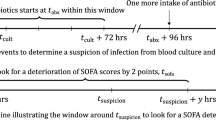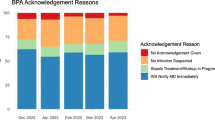Abstract
Sepsis is a life-threatening condition with a high in-hospital mortality rate. The timing of antibiotic administration poses a critical problem for sepsis management. Existing work studying antibiotic timing either ignores the temporality of the observational data or the heterogeneity of the treatment effects. Here we propose a novel method (called T4) to estimate treatment effects for time-to-treatment antibiotic stewardship in sepsis. T4 estimates individual treatment effects by recurrently encoding temporal and static variables as potential confounders, and then decoding the outcomes under different treatment sequences. We propose mini-batch balancing matching that mimics the randomized controlled trial process to adjust the confounding. The model achieves interpretability through a global-level attention mechanism and a variable-level importance examination. Meanwhile, we equip T4 with an uncertainty quantification to help prevent overconfident recommendations. We demonstrate that T4 can identify effective treatment timing with estimated individual treatment effects for antibiotic stewardship on two real-world datasets. Moreover, comprehensive experiments on a synthetic dataset exhibit the outstanding performance of T4 compared with the state-of-the-art models on estimation of individual treatment effect.
This is a preview of subscription content, access via your institution
Access options
Access Nature and 54 other Nature Portfolio journals
Get Nature+, our best-value online-access subscription
$29.99 / 30 days
cancel any time
Subscribe to this journal
Receive 12 digital issues and online access to articles
$119.00 per year
only $9.92 per issue
Buy this article
- Purchase on Springer Link
- Instant access to full article PDF
Prices may be subject to local taxes which are calculated during checkout





Similar content being viewed by others
Data availability
The MIMIC-III dataset is publicly available from PhysioNet (https://mimic.physionet.org/). AmsterdamUMCdb is publicly available from the Amsterdam Medical Data Science website (https://amsterdammedicaldatascience.nl/).
Code availability
The source code for this paper can be downloaded from the GitHub repository at https://github.com/ruoqi-liu/T4 or the Zenodo repository at https://doi.org/10.5281/zenodo.7683025.
References
Rhee, C. et al. Incidence and trends of sepsis in us hospitals using clinical vs claims data, 2009-2014. JAMA 318, 1241–1249 (2017).
Arefian, H. et al. Hospital-related cost of sepsis: a systematic review. J. Infect. 74, 107–117 (2017).
Buchman, T. G. et al. Sepsis among medicare beneficiaries: 1. the burdens of sepsis, 2012–2018. Crit. Care Med. 48, 276 (2020).
Treatment for sepsis. Sepsis Alliance https://www.sepsis.org/sepsis-basics/treatment/ (2021).
Dellinger, R. P. et al. Surviving Sepsis Campaign: international guidelines for management of severe sepsis and septic shock, 2012. Intensive Care Med. 39, 165–228 (2013).
Bacterial-infections in sepsis. Sepsis Alliance https://www.sepsis.org/sepsisand/bacterial-infections/ (2021).
Moss, S. R. & Prescott, H. C. Current controversies in sepsis management. Semin. Respir. Crit. Care Med. 40, 594–603 (2019).
Klompas, M. & Rhee, C. Current sepsis mandates are overly prescriptive, and some aspects may be harmful. Crit. Care Med. 48, 890–893 (2020).
Rhodes, A. et al. Surviving Sepsis Campaign: International Guidelines for Management of Sepsis and Septic Shock: 2016. Intensive care medicine. 43, 304–377 (2017).
Levy, M. M., Evans, L. E. & Rhodes, A. The Surviving Sepsis Campaign bundle: 2018 update. Intensive Care Med. 44, 925–928 (2018).
Kalil, A. C., Johnson, D. W., Lisco, S. J. & Sun, J. Early goal-directed therapy for sepsis: a novel solution for discordant survival outcomes in clinical trials. Crit. Care Med. 45, 607–614 (2017).
Liu, V. X. et al. The timing of early antibiotics and hospital mortality in sepsis. Am. J. Resp. Crit. Care Med. 196, 856–863 (2017).
Seymour, C. W. et al. Time to treatment and mortality during mandated emergency care for sepsis. N. Engl. J. Med. 376, 2235–2244 (2017).
IDSA Sepsis Task Force. Infectious Diseases Society of America (IDSA) position statement: why IDSA did not endorse the Surviving Sepsis Campaign guidelines. Clin. Infect. Dis. 66, 1631–1635 (2018).
Rhee, C., Strich, J. R., Klompas, M., Yealy, D. M. & Masur, H. SEP-1 has brought much needed attention to improving sepsis care… but now is the time to improve SEP-1. Crit. Care Med. 48, 779–782 (2020).
Zhang, D., Micek, S. T. & Kollef, M. H. Time to appropriate antibiotic therapy is an independent determinant of postinfection ICU and hospital lengths of stay in patients with sepsis. Crit. Care Med. 43, 2133–2140 (2015).
Shashikumar, S. P., Josef, C., Sharma, A. & Nemati, S. DeepAISE-an interpretable and recurrent neural survival model for early prediction of sepsis. Artificial intelligence in medicine 113, 102036 (2019).
Tsoukalas, A., Albertson, T. & Tagkopoulos, I. From data to optimal decision making: a data-driven, probabilistic machine learning approach to decision support for patients with sepsis. JMIR Med. Inform. 3, e3445 (2015).
Raghu, A. et al. Deep reinforcement learning for sepsis treatment. Preprint at https://doi.org/10.48550/arXiv.1711.09602 (2017).
Raghu, A., Komorowski, M. & Singh, S. Model-based reinforcement learning for sepsis treatment. Preprint at https://doi.org/10.48550/arXiv.1811.09602 (2018).
Komorowski, M., Celi, L. A., Badawi, O., Gordon, A. C. & Faisal, A. A. The artificial intelligence clinician learns optimal treatment strategies for sepsis in intensive care. Nat. Med. 24, 1716–1720 (2018).
Utomo, C. P., Li, X. & Chen, W. Treatment recommendation in critical care: a scalable and interpretable approach in partially observable health states. In Int. Conf. Information Systems (2018).
Gal, Y. & Ghahramani, Z. Dropout as a Bayesian approximation: representing model uncertainty in deep learning. In Int. Conf. Machine Learning ’16 (2016).
Johnson, A. E. et al. MIMIC-III, a freely accessible critical care database. Sci. Data 3, 160035 (2016).
Thoral, P. J. et al. Sharing ICU patient data responsibly under the Society of Critical Care Medicine/European Society of Intensive Care Medicine Joint Data Science Collaboration: the Amsterdam University Medical Centers database (AmsterdamUMCdb) example. Crit. Care Med. 49, e563 (2021).
Hochreiter, S. & Schmidhuber, J. Long short-term memory. Neural Comput. 9, 1735–1780 (1997).
Rosenbaum, P. R. & Rubin, D. B. The central role of the propensity score in observational studies for causal effects. Biometrika 70, 41–55 (1983).
Singer, M. et al. The third international consensus definitions for sepsis and septic shock (Sepsis-3). JAMA 315, 801–810 (2016).
Vincent, J.-L. et al. The SOFA (Sepsis-related Organ Failure Assessment) score to describe organ dysfunction/failure. 22, 707–710 (1996).
Vincent, J.-L. et al. Use of the SOFA score to assess the incidence of organ dysfunction/failure in intensive care units: results of a multicenter, prospective study. Crit. Care Med. 26, 1793–1800 (1998).
Ferreira, F. L., Bota, D. P., Bross, A., Mélot, C. & Vincent, J.-L. Serial evaluation of the SOFA score to predict outcome in critically ill patients. JAMA 286, 1754–1758 (2001).
Diabetes-diagnosis and treatment. Mayo Clinic https://www.mayoclinic.org/diseases-conditions/diabetes/diagnosis-treatment/drc-20371451 (2021).
Wager, S. & Athey, S. Estimation and inference of heterogeneous treatment effects using random forests. J. Am. Stat. Assoc. 113, 1228–1242 (2018).
Shalit, U., Johansson, F. D. & Sontag, D. Estimating individual treatment effect: generalization bounds and algorithms. In Int. Conf. Machine Learning 3076–3085 (PMLR, 2017).
Seber, G. A. & Lee, A. J. Linear Regression Analysis Vol. 329 (John Wiley and Sons, 2012).
Liaw, A. & Wiener, M. et al. Classification and regression by randomforest. R News 2, 18–22 (2002).
Wang, L. (ed.) Support Vector Machines: Theory and Applications (Springer, 2005).
Hill, J. L. Bayesian nonparametric modeling for causal inference. J. Comput. Graph. Stat. 20, 217–240 (2011).
Yoon, J., Jordon, J. & van der Schaar, M. GANITE: estimation of individualized treatment effects using generative adversarial nets. In Int. Conf. Learning Representations (2018).
Shi, C., Blei, D. & Veitch, V. Adapting neural networks for the estimation of treatment effects. In NeurIPS’19 2503–2513 (2019).
Lim, B. Forecasting treatment responses over time using recurrent marginal structural networks. In NeurIPS’18 7483–7493 (2018).
Bica, I., Alaa, A. M., Jordon, J. & van der Schaar, M. Estimating counterfactual treatment outcomes over time through adversarially balanced representations. In Int. Conf. Learning Representations (2020).
Li, R. et al. G-Net: a recurrent network approach to g-computation for counterfactual prediction under a dynamic treatment regime. In Machine Learning for Health 282–299 (PMLR, 2021).
Dupuis, C. & Timsit, J.-F. Antibiotics in the first hour: is there new evidence? Expert Rev. Anti Infect. Ther. 19, 45–54 (2021).
Im, Y. et al. Time-to-antibiotics and clinical outcomes in patients with sepsis and septic shock: a prospective nationwide multicenter cohort study. Crit. Care 26, 19 (2022).
Alam, N. et al. Prehospital antibiotics in the ambulance for sepsis: a multicentre, open label, randomised trial. Lancet Resp. Med. 6, 40–50 (2018).
Rhee, C. et al. Prevalence of antibiotic-resistant pathogens in culture-proven sepsis and outcomes associated with inadequate and broad-spectrum empiric antibiotic use. JAMA Netw. Open 3, e202899 (2020).
Singer, M. Antibiotics for sepsis: does each hour really count, or is it incestuous amplification? Am. J. Respir. Crit. Care Med. 196, 800–802 (2017).
Chen, R. J., Lu, M. Y., Chen, T. Y., Williamson, D. F. & Mahmood, F. Synthetic data in machine learning for medicine and healthcare. Nat. Biomed. Eng. 5, 493–497 (2021).
Strich, J. R., Heil, E. L. & Masur, H. Considerations for empiric antimicrobial therapy in sepsis and septic shock in an era of antimicrobial resistance. J. Infect. Dis. 222, S119–S131 (2020).
Severe Sepsis and Septic Shock Antibiotic Guide (Stanford Health, 2017).
Rubin, D. B. Causal inference using potential outcomes: design, modeling, decisions. J. Am. Stat. Assoc. 100, 322–331 (2005).
Robins, J. M. & Hernán, M. A. in Longitudinal Data Analysis (eds. Fitzmaurice, G. et al.) 553–599 (Chapman and Hall, 2009).
Robins, J. M., Hernán, M. A. & Brumback, B. Marginal structural models and causal inference in epidemiology. Epidemiology 11, 550–560 (2000).
Hernán, M. A. & Robins, J. M. Causal Inference (2010).
Schwab, P., Linhardt, L. & Karlen, W. Perfect match: a simple method for learning representations for counterfactual inference with neural networks. Preprint at https://doi.org/10.48550/arXiv.1810.00656 (2018).
Jesson, A., Mindermann, S., Shalit, U. & Gal, Y. Identifying causal-effect inference failure with uncertainty-aware models. Adv. Neural Inf. Process. Syst. 33, 11637–11649 (2020).
Acknowledgements
This work was funded in part by the National Science Foundation under award number IIS-2145625 and by the National Institutes of Health under award number UL1TR002733. The content is solely the responsibility of the authors and does not necessarily represent the official views of the National Science Foundation or the National Institutes of Health.
Author information
Authors and Affiliations
Contributions
P.Z. conceived the project. R.L. and P.Z. developed the method. R.L. conducted the experiments. R.L. and P.Z. analysed the results. R.L., K.M.H., J.M.C. and P.Z. wrote the manuscript. All authors read and approved the final manuscript.
Corresponding author
Ethics declarations
Competing interests
The authors declare no competing interests.
Peer review
Peer review information
Nature Machine Intelligence thanks Deepti Gurdasani and the other, anonymous, reviewer(s) for their contribution to the peer review of this work.
Additional information
Publisher’s note Springer Nature remains neutral with regard to jurisdictional claims in published maps and institutional affiliations.
Supplementary information
Supplementary Information
Additional related work, additional details on experimental setup, additional experimental results.
Rights and permissions
Springer Nature or its licensor (e.g. a society or other partner) holds exclusive rights to this article under a publishing agreement with the author(s) or other rightsholder(s); author self-archiving of the accepted manuscript version of this article is solely governed by the terms of such publishing agreement and applicable law.
About this article
Cite this article
Liu, R., Hunold, K.M., Caterino, J.M. et al. Estimating treatment effects for time-to-treatment antibiotic stewardship in sepsis. Nat Mach Intell 5, 421–431 (2023). https://doi.org/10.1038/s42256-023-00638-0
Received:
Accepted:
Published:
Issue Date:
DOI: https://doi.org/10.1038/s42256-023-00638-0
This article is cited by
-
Causal machine learning for predicting treatment outcomes
Nature Medicine (2024)



